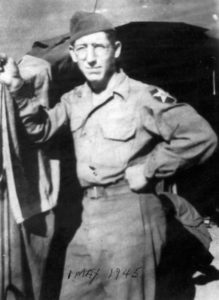by Gerald White, 2 INFD, 23 REGT, CO M

It was a very tough, long basic training in the sands of Florida, very difficult for a young, dumb, skinny kid. There were lots of snakes and wild boar. In mid-November 1944, I was given a fifteen-day leave, then reported back to Fort Dix for shipment overseas. On 8 January 1945, we left New York harbor on the Queen Elizabeth with approximately twelve thousand troops. On the ocean trip, we had two sub alerts. We landed at Glasgow, Scotland on 13 January 1945, and were sent directly to a port in southern England for transfer to a port in France. We were loaded on cattle cars (forty and eight) for assignment to forward units.
I was assigned to M Company of the 23rd Infantry of the Second Division on 15 January 1945 someplace in Belgium. It was very cold, with lots of snow. Sometimes there was a lot of shelling by the Germans, and many battles around the Omdemolivildengin Pass near St. Vith, Belgium as part of the Battle of the Bulge. We would cut trees down with C-4 to use for bunkers, as the ground was so frozen that we couldn’t dig foxholes. I was assigned as an ammo bearer, mostly mortars.
On 31 January, while on the Siegfried Line near Wehlerscheid, Germany, I was wounded. I was working KP, but don’t remember that I had done anything wrong to have to be there! I was told to burn up some excess food. So I finished piling up the food, applied some flammable fluid to it and lit it. A tremendous blast resulted, likely because there was an undetected mine beneath where the food had been piled. I was blown away from the food pile. I suffered burns and plenty of singed hair, and was evacuated to Beaujon hospital in Paris, France. Two officers reported that I was MIA, and this was reported to my family. Ten days later I was back with the unit, but my family was never told that I had been located, leaving them in complete darkness about my status!
Our unit crossed the Ruhr River 2 February 1945 on pontoon boats, with lots of action. I rejoined my unit, and we pushed ahead. On 21 March 1945 we crossed the Rhine River five miles south of the famous Remagen Bridge. At this point we were moving fast. I received some advanced training and became a mortarman. We were on mechanized vehicles: half tracks, tanks, etc. We had a major battle outside of Leipzig. Then the tide turned, really turned. We took out a lot of the enemy. At one point, I looked up at an Allied bombing formation. There were so many airplanes that it looked like a big cloud passing over us. We advanced to the Mulde River where we met up with the Russians. The unit moved south to Pilsen, Czechoslovakia. At this point, most of the Germans were giving up. On 8 May 1945 the war was over.
On 10 July 1945 the Division traveled by train to a port in France. On 13 July we were loaded on a ship and departed France. We arrived at Camp Kilmer, New Jersey. We were given thirty days leave, then were to report to Camp Swift, Texas. At Camp Swift the Division was to be regrouped for extensive training for assignment to an unknown location. I was home on leave on VJ Day. Happy Days! On 23 August, I reported in at Camp Swift, Texas and started advance training. The day before Thanksgiving, the complete division moved to Camp Stoneman, California by train. On Thanksgiving day, the division marched in a ticker- tape parade through San Francisco. There were very large crowds. The next day trainloads of equipment and troops—me included—were on the way to Fort Lewis, Washington. The division received new people, as the home of the division would be at Fort Lewis. I was at Fort Lewis until 28 June 1946. A long trainload of GIs was loaded for shipment across the USA for discharge. We arrived at Fort Dix on 2 July and I was discharged on 4 July 1946. AMEN!!
I left the service and went to Morrisville College on the GI Bill. I went to work at the Seneca Army Depot as a civilian, working in the surveillance office. I became a munitions inspector, QA Specialist (QASAS), and did this for 37 years. I also served the Army in Korea as a civilian. It was while I was at Seneca that I met Pearl Johnson, the woman who became my wife. Of all the good things that happened to me while serving in or working for the Army, Pearl was the best!
I retired as a QASAS-S Chief of the Missile Branch in May 1985, at Anniston Ordnance Depot, Alabama.
